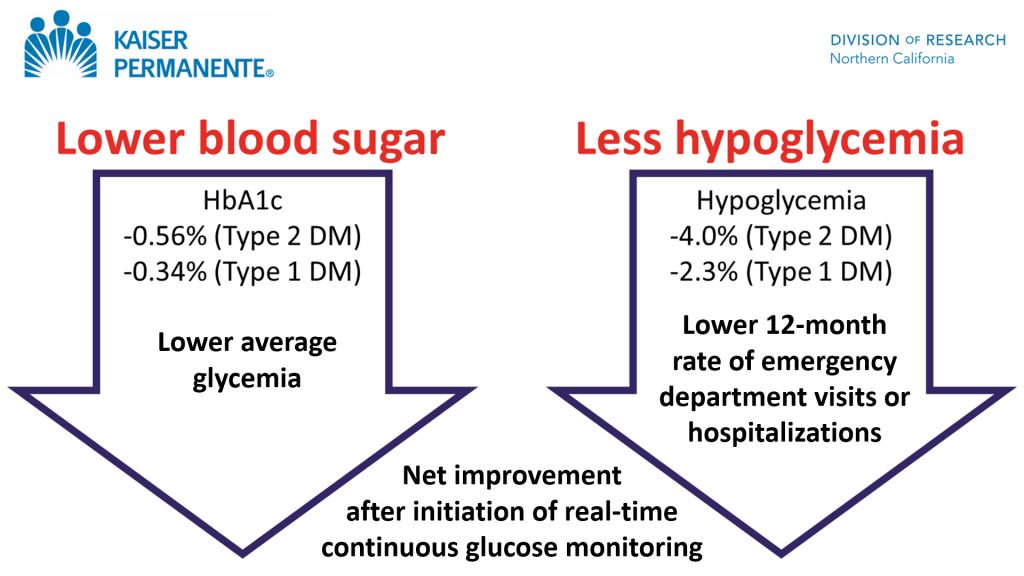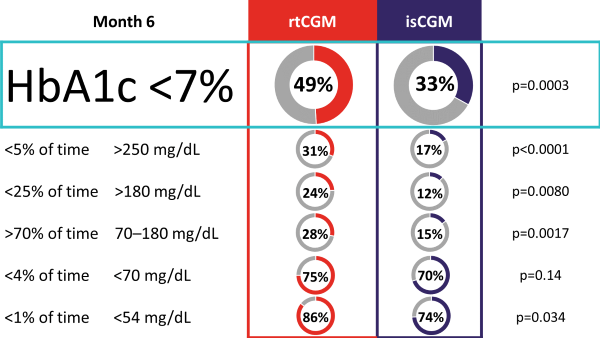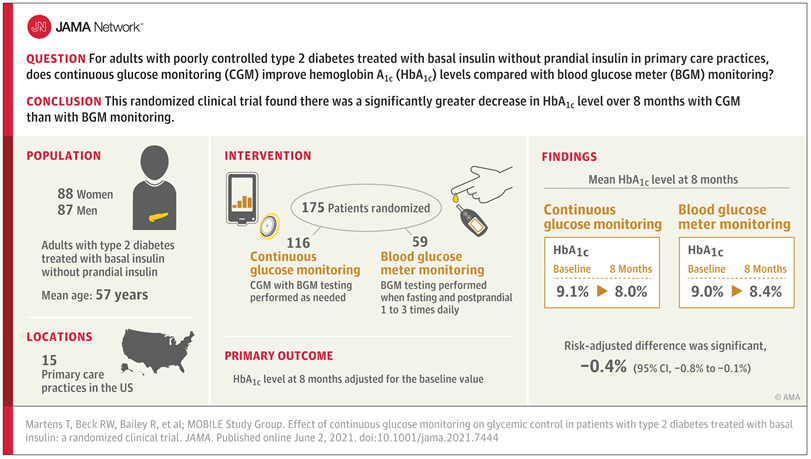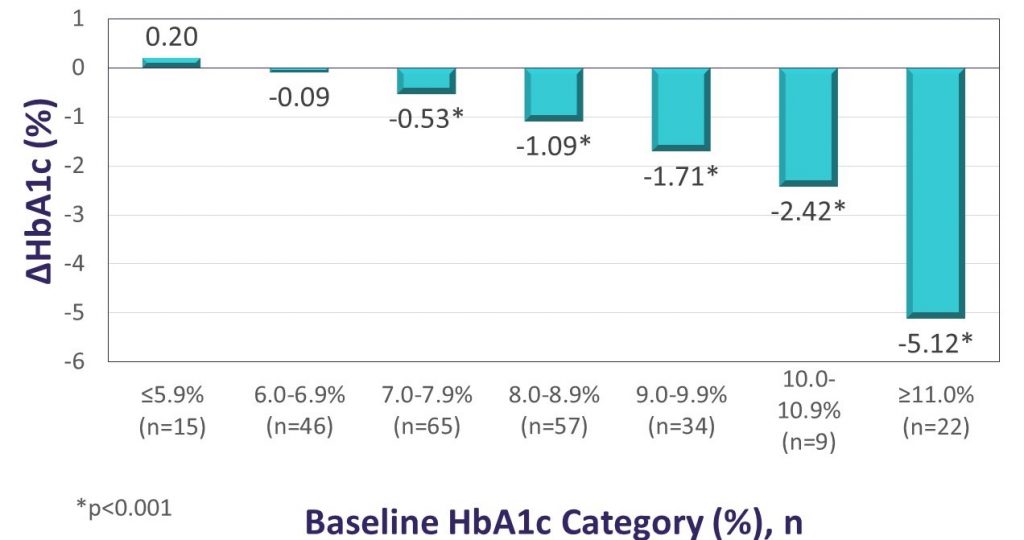Clinical Outcomes

Source: The Journal of the American Medical Association
Key Takeaways: Continuous Glucose Monitoring improved outcomes more than intermittent testing of blood glucose in 41,753 patients with insulin-treated diabetes.
“Our real-world study found that in patients with insulin-treated diabetes, initiating a continuous glucose monitor substantially improved blood glucose control and cut the rate of emergency room visits for hypoglycemia in half.”1
Andrew J. Karter, PhD, Senior Research Scientist at Kaiser Permanente Division of Research

1Shaffer R. Real-time CGM lowers HbA1c, reduces ED visits in insulin-treated diabetes. Endocrine Today. June 2021. https://www.healio.com/news/endocrinology/20210607/realtime-cgm-lowers-hba1c-reduces-ed-visits-in-insulintreated-diabetes. Accessed June 24, 2021.
Learn MoreSource: The Journal of the American Medical Association
Authors: Monica E. Peek, MD, MPH, MS; Celeste C. Thomas, MD, MS
“…the studies by Karter et al. and Martens et al. provide additional evidence that patients with type 2 diabetes benefit from the use of CGM in terms of improved HbA1c level, time spent in the target blood glucose range, and reduced hypoglycemic episodes…”
“…institutional changes that promote its use in primary care will go a long way to improving diabetes control and reducing complications, particularly among the populations most in need. The time has come to broaden access to CGM for patients with type 2 diabetes.”
Learn More

Source: The Lancet – June 2021
Key Takeaways:
The ALERTT1 trial is the first 6-month, multicenter, prospective, randomized controlled trial comparing rtCGM with isCGM in 254 adults with type 1 diabetes, who previously used isCGM. Mean HbA1c was 7·4% (58 mmol/mol) and a minority of the study population was hypoglycemia unaware (44 [17%] people) or had a history of severe hypoglycemia (29 [11%]). Most (205 [81%]) were treated with multiple daily injections. Findings showed that in an unselected group of people with type 1 diabetes, 6-month use of rtCGM with alert functionality improved time in range (70–180 mg/dL [3.9–10.0 mmol/L]), while HbA1c, time in clinically significant hypoglycemia (< 54 mg/dL [3.0 mmol/L), and hyperglycemia (180 mg/dL [10.0 mmol/L]) were reduced. Additionally, more people on rtCGM achieved glycemic targets as defined by international consensus guidelines, and had less frequently severe hypoglycemia. Moreover, rtCGM users experienced less hypoglycemia worry and higher treatment satisfaction at the end of study.
Percentage of Participants Achieving Consensus Targets

Source: Diabetes Technology and Therapeutics
Key Takeaway: The CONCEPTT (CGM in pregnant women with type 1 diabetes) trial provided high-quality, randomized-controlled trial data demonstrating that the use of real-time CGM was associated with lower HbA1c at 34 weeks, suggesting improved maternal glucose levels during the late second and early third trimesters. Importantly, this was accompanied by 7% higher time in range (TIR) and 5% lower time above range (TAR) without increasing maternal hypoglycemia. Beyond impacting surrogate markers of maternal glycemia, using CGM led to clinically significant reductions in large for gestational-age infants, neonatal hypoglycemia, and neonatal intensive care unit (NICU) admissions.1 A systematic review combining data from CONCEPTT with that of the type 1 diabetes arm of the GlucoMOMS trial also showed evidence for a reduction in preeclampsia.
Learn MoreSource: Diabetes Technology and Therapeutics
Key Takeaway: The Landmark study demonstrated significant glycemic and QoL benefits for first time CGM use among individuals using intensive insulin therapy to manage either T1D or T2D. After approximately 12 weeks of Dexcom G6 use, participants had a mean absolute reduction in HbA1c levels of 1.1%, and more than half of those with initial HbA1c values >7% experienced absolute HbA1c reductions of >1%. The reduction in HbA1c observed in Landmark was similar for patients with T1D and T2D and was more pronounced for participants with higher baseline HbA1c, consistent with observations from the DIAMOND randomized controlled trial. Significant reductions in diabetes distress and hypoglycemic concerns were also observed. In the Landmark study, there was no standardized training or intervention at CGM initiation, suggesting that the glycemic benefits can be realized without formal instruction.
Changes in HbA1c according to baseline HbA1c level
Learn MoreSource: National Institute for Health and Care Excellence (NICE) Guideline – Diabetes in Pregnancy: Management from Preconception to the Postnatal Period (2020)
Key Takeaway: In December 2020, NICE reviewed the evidence and changed the recommendations on intermittently scanned CGM (isCGM, also commonly referred to as flash) and continuous glucose monitoring during pregnancy for women with type 1 diabetes.
Recommendations for Managing Diabetes During Pregnancy-Intermittently scanned CGM and continuous glucose monitoring
| 1.3.17 | Offer continuous glucose monitoring (CGM) to all pregnant women with type 1 diabetes to help them meet their pregnancy blood glucose targets and improve neonatal outcomes. |
| 1.3.18 | Offer intermittently scanned CGM (isCGM, commonly referred to as flash) to pregnant women with type 1 diabetes who are unable to use continuous glucose monitoring or express a clear preference for it. |
| 1.3.19 | Consider continuous glucose monitoring for pregnant women who are on insulin therapy but do not have type 1 diabetes, if they have problematic severe hypoglycaemia (with or without impaired awareness of hypoglycaemia) or they have unstable blood glucose levels that are causing concern despite efforts to optimise glycaemic control. |
| 1.3.20 | For pregnant women who are using isCGM or continuous glucose monitoring, a member of the joint diabetes and antenatal care team with expertise in these systems should provide education and support (including advising women about sources of out-of-hours support). |
For a short explanation of why the committee made the 2020 recommendations and how they might affect practice, see the rationale and impact section on flash and continuous glucose monitoring on pages 35-36 in the Guideline. Full details of the evidence and the committee’s discussion are in evidence review A: continuous glucose monitoring.
LEARN MORESource: AMCP Science and Innovation Theater Webinar – November 17, 2020
Key Takeaway: Advances in the Dexcom G6 technology are an important CGM differentiator that allows for improved safety, glycemic management and telehealth opportunities for persons 2 years and older through the use of real-time CGM data with features such as a predictive Urgent Low Soon alert, customizable high/low glycemic threshold alerts, remote monitoring and the CLARITY diabetes management application.
Learn MoreSource:
Key Takeaway: Real-world data from the German/Austrian Prospective Diabetes Follow-Up Registry showed real-time continuous glucose monitoring was associated with a higher percentage of Time-in-Range and improved metabolic stability as compared to intermittent scanning continuous glucose monitoring.
Learn MoreSource:
Key Takeaway: A recent systematic review and meta-analysis of 15 randomized controlled trials involving 2,461 patients showed greater improvement in mean hemoglobin A1c, time in target range, and time above range with use of real-time continuous glucose monitoring as compared to intermittently scanned continuous glucose monitoring.
Learn More
